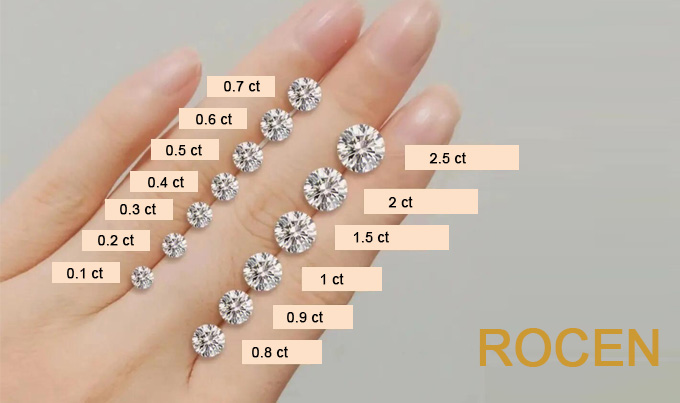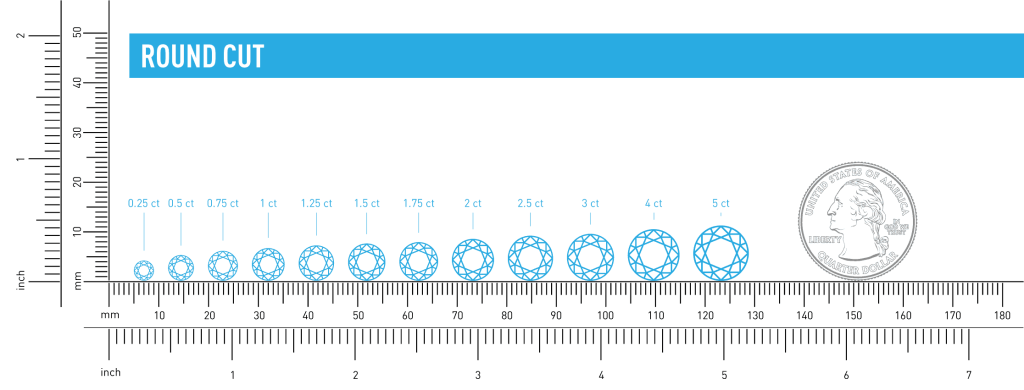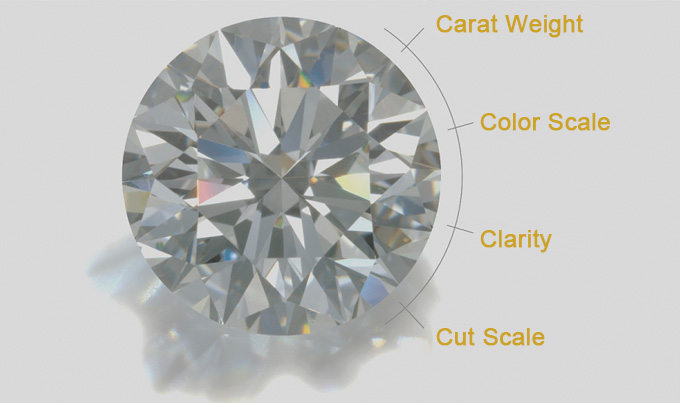When shopping for a diamond, whether for an engagement ring, a special gift, or an investment, understanding the 4Cs—Cut, Color, Clarity, and Carat—is essential. Developed by the Gemological Institute of America (GIA) in the 1950s, this universal grading system provides a standardized way to evaluate diamond quality. Each “C” plays a critical role in determining a diamond’s beauty, rarity, and value. In this comprehensive guide, we’ll delve into the science and artistry behind the 4Cs, empowering you to make informed decisions and select a diamond that aligns with your preferences and budget.
1. Cut: The Master of Brilliance
What Is Diamond Cut?
The cut of a diamond refers to its proportions, symmetry, and polish—factors that directly influence how light interacts with the stone. Unlike shape (e.g., round, princess, or oval), cut is a measure of craftsmanship. A well-cut diamond will reflect light internally and externally, creating the mesmerizing sparkle known as fire (flashes of color) and brilliance (white light return).
The Science of Light Performance
When light enters a diamond, it bends (refracts) and bounces off the facets. A poorly cut diamond allows light to escape through the sides or bottom, resulting in a dull appearance. In contrast, an Excellent or Ideal cut diamond directs maximum light back through the top (the table), creating unparalleled radiance.
Cut Grading Scale:
- Excellent/Ideal: Exceptional light reflection; highest brilliance.
- Very Good: Slightly less precise but still highly reflective.
- Good: Moderate brilliance; a budget-friendly option.
- Fair/Poor: Noticeably dull; light leakage reduces sparkle.
Why Cut Matters Most
Of the 4Cs, cut has the greatest impact on a diamond’s beauty. Even a high-color, high-clarity diamond will lack allure if poorly cut. For maximum sparkle, prioritize cut quality over other factors.
Pro Tip: For round brilliant diamonds, stick to Excellent or Ideal cuts. For fancy shapes (e.g., emerald or pear), symmetry and polish become even more critical, as these stones lack standardized cut grades.

2. Color: The Spectrum of Whiteness
Understanding Diamond Color
Diamond color is graded on a scale from D (colorless) to Z (light yellow or brown). The less color a diamond exhibits, the higher its grade and value. Subtle color differences are invisible to untrained eyes but significantly affect pricing.
Color Grading Scale:
- D-F: Colorless (rarest and most expensive).
- G-J: Near-colorless (appear white to the naked eye).
- K-M: Faint yellow tint (visible in larger stones).
- N-Z: Noticeable yellow/brown hue.
How Color Affects Appearance
In white diamonds, colorlessness enhances brilliance by allowing more light to pass through. However, personal preferences and settings matter:
- Yellow Gold Settings: Mask faint yellow tints (allows lower color grades like J or K).
- Platinum or White Gold: Highlight a diamond’s true color (opt for G or H for value).
Exception: Fancy-colored diamonds (e.g., pink, blue, or yellow) fall outside this scale and are valued for their vibrant hues.
Balancing Color and Budget
For most buyers, G-H grades offer the best balance: nearly colorless to the eye but more affordable than D-F stones. Avoid overspending on higher color grades unless you prioritize absolute perfection.

3. Clarity: The Quest for Purity
What Is Diamond Clarity?
Clarity measures internal imperfections (inclusions) and surface flaws (blemishes). These natural marks form during a diamond’s creation under extreme heat and pressure. The fewer the flaws, the rarer and more valuable the stone.
Clarity Grading Scale:
- Flawless (FL): No inclusions or blemishes under 10x magnification (extremely rare).
- Internally Flawless (IF): No inclusions, minor surface blemishes.
- VVS1-VVS2: Minute inclusions invisible to the naked eye.
- VS1-VS2: Minor inclusions visible under magnification but not to the naked eye.
- SI1-SI2: Noticeable inclusions under magnification; may be visible in larger stones.
- I1-I3: Obvious inclusions affecting brilliance and durability.
The Illusion of Perfection
Most inclusions in VS or SI grades are invisible without a jeweler’s loupe. For example, an SI1 diamond may appear flawless once set in a ring. Prioritize “eye-clean” stones over higher clarity grades to maximize value.
Red Flags: Avoid diamonds with inclusions near the edges (risk of chipping) or dark spots that disrupt light performance.

4. Carat: The Weight of Desire
What Is Carat Weight?
Carat (ct) measures a diamond’s weight, with 1 carat equal to 0.2 grams. Larger diamonds are rarer, making carat a key driver of price. However, carat alone doesn’t determine size perception—cut and shape also play roles.
Carat vs. Size:
- A shallow-cut 1.5ct diamond may appear larger than a deep-cut 2ct stone.
- Spread-out shapes (e.g., oval or marquise) look larger per carat than round brilliants.
The Psychology of Carat
Cultural trends and personal preferences influence carat choices. While bigger stones are often associated with status, a well-proportioned diamond with excellent cut and color can outshine a larger, lower-quality stone.
Smart Carat Choices
- Consider Finger Size: A 1ct diamond looks larger on a size 4 finger than a size 8.
- Buy Slightly Under: A 0.9ct diamond costs significantly less than a 1ct stone but appears nearly identical.
- Prioritize Quality: A smaller, high-cut-grade diamond often sparkles more than a larger, poorly cut one.


5. Balancing the 4Cs: A Strategic Approach
The Art of Compromise
Few buyers can maximize all 4Cs within a budget. Here’s how to prioritize:
For Maximum Sparkle:
- Cut: Never compromise—choose Excellent/Ideal.
- Color: Aim for G-H (near-colorless).
- Clarity: Select VS2-SI1 (eye-clean).
- Carat: Adjust size to fit your budget.
For Larger Stones on a Budget:
- Cut: Very Good or Good.
- Color: I-J (pair with yellow gold).
- Clarity: SI2 (ensure inclusions are not visible).
- Carat: Opt for 1.5ct+.
Certification Is Key
Always purchase diamonds graded by reputable labs like GIA or AGS. Certificates provide an unbiased assessment of the 4Cs and protect against overgrading.
6. Beyond the 4Cs: Additional Considerations
- Fluorescence: Some diamonds emit a blue glow under UV light. Faint fluorescence can make a yellow-toned diamond appear whiter, but strong fluorescence may cause haziness.
- Shape: Round brilliants maximize sparkle, while fancy shapes (e.g., cushion or radiant) offer unique aesthetics.
- Setting Style: Halo settings or thin bands can make the center stone appear larger.
Conclusion: The 4Cs in Harmony
The allure of a diamond lies in the interplay of its Cut, Color, Clarity, and Carat. By understanding how each “C” contributes to beauty and value, you can make confident choices tailored to your priorities. Remember, the “perfect” diamond isn’t defined by top grades in all categories but by the harmony of the 4Cs within your vision and budget. Whether you seek a dazzling showstopper or a subtle symbol of love, this guide equips you with the knowledge to find a diamond that truly shines.
